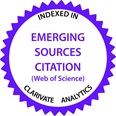Abstract
In her paper, the author takes up the issue of integrating capital and financial market of the EU. She points out that the integration processes were long and often encountered multiple impediments, and the level of integration differs between the segments under analysis (e.g. if the capital and financial market is split into bulk trade market and retail market, it shows that the stage of integrating retail market is inappreciable). The author emphasizes that a more complete integration of the financial markets of the EU should prove favourable both macro- and microeconomically, i.e. to entrepreneurs, investors and consumers. The author proceeds with an assessment of integration processes on Polish capital market. She characterizes the stage of liberalization in capital flows between Poland and the EU, as well as direct foreign investments (Polish abbrev. BIZ) between the EU and Poland. Owing to the liberalization of flows in the pre-accession period a group of companies emerged in Polish economy, which has been capable of competing on a unifirm internal market. It can be expected that the group of companies subject to analysis will constitute a developing segment of Polish economy, able to face the increasing competitiveness on the internal market. Also, the processes will emerge in Polish economy which are observed at the stage of realizing and functioning of the uniform internal market of the European Community, such as cost reduction, competitive pressure enforcing restructurization of companies, as well as improvements and technological development in the long term. The author emphasizes that the processes under way in different segments of the capital market in Poland point to its increasing internalization and merger with the uniform capital and financial market of the EU.
Abstrakt
Autorka podejmuje w artykule problematykę integracji rynku kapitałowo-finansowego UE. Podkreśla, iż procesy integracyjne były długotrwałe i napotykały liczne przeszkody, zaś stopień integracji różni się w zależności od rozpatrywanego segmentu (przykładowo, jeżeli rynek kapitałowo-finansowy zostanie podzielony na rynek hurtowy i detaliczny, to okazuje się, że stopień integracji rynku detalicznego jest znikomy). Autorka podkreśla, iż pełniejsza integracja rynków finansowych UE powinna przynieść zarówno korzyści makroekonomiczne, jak i mikroekonomiczne, tj. przedsiębiorcom, inwestorom i konsumentom. W dalszej części artykułu autorka ocenia procesy integracyjne na rynku kapitału w Polsce. Autorka charakteryzuje stan liberalizacji przepływów kapitałowych między Polska a Unią Europejską, a także bezpośrednie inwestycje zagraniczne (BIZ) UE w Polsce. Dzięki liberalizacji przepływów w okresie przedczłonkowskim powstała w polskiej gospodarce grupa przedsiębiorstw zdolna do konkurowania na jednolitym rynku wewnętrznym. W dalszej perspektywie można oczekiwać, że analizowana grupa przedsiębiorstw będzie stanowić rozwojowy segment polskiej gospodarki zdolny do sprostania narastającej konkurencji na rynku wewnętrznym. W polskiej gospodarce ujawnią się także procesy obserwowane na etapie realizacji i funkcjonowania jednolitego rynku wewnętrznego WE, takie jak redukcja kosztów, presja konkurencyjna wymuszająca restrukturyzację firm, a w długim okresie także innowacje i postęp techniczny. Autorka podkreśla, że procesy zachodzące w różnych segmentach rynku kapitałowego w Polsce wskazują na rosnące jego umiędzynarodowienie i włączanie się w jednolity rynek kapitałowo-finansowy UE.
Recommended Citation
Witkowska, J. (2005). Integracja rynku kapitałowo-finansowego Unii Ueropejskiej. Efekty dla nowych krajów członkowskich, na przykładzie Polski. Problemy Zarządzania, 3(9), 21-32. Retrieved from https://press.wz.uw.edu.pl/ems/vol3/iss9/2
First Page
21
Last Page
32
Page Count
11
Publisher
University of Warsaw








